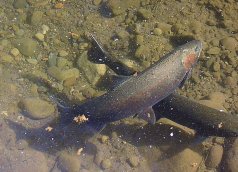|
Recovery Plan Issued for Endangered
Steelhead in Southern California
Fisheries
Biologists Present a Roadmap to Restore Historic Steelhead Runs
to the Los Padres National Forest
California biologists, farmers,
conservationists, and fishermen have been buzzing about the
recent release of the Final Southern Steelhead Recovery Plan by
the National Marine Fisheries Service in January 2012. Focused
on an area from the Santa Maria River to the California/Mexico
border, the Recovery Plan will serve as a guide to restore
historic steelhead
runs in southern California, including several major watersheds
in the Los Padres National Forest – the Santa Clara River
(including Sespe and Piru creeks), the Ventura River (including
Matilija Creek), the Santa Ynez River, the Sisquoc River, and
several smaller coastal drainages.
 Once
numbering in the tens of thousands of fish, southern steelhead
populations plummeted in the past several decades. The Recovery
Plan is a ‘blueprint’ that describes the measures that must be
taken over the next several years to bring the southern
steelhead back from the brink of extinction. Once
numbering in the tens of thousands of fish, southern steelhead
populations plummeted in the past several decades. The Recovery
Plan is a ‘blueprint’ that describes the measures that must be
taken over the next several years to bring the southern
steelhead back from the brink of extinction.
Los Padres ForestWatch has been
involved in the development of the Plan from start to finish,
providing the National Marine Fisheries Service with input along
the way (along with other steelhead experts, the public, and
federal, state, and local agencies.) The Los Padres National
Forest is of high priority when it comes to steelhead recovery
efforts because many of the streams providing pristine spawning
habitat originate in and flow through the forest.
Threats to Our Region's
Steelhead
The largest threats facing the
steelhead of the Los Padres National Forest, and southern
California as a whole, are impassable barriers such as dams,
culverts, and road crossings, all of which prevent steelhead
from swimming upstream from the ocean to their historic spawning
grounds higher up in the watershed. Water diversions for
household, agricultural, and industrial use also leave less
water for fish, reducing streamflows and narrowing the window of
opportunity for steelhead to complete their life cycle.
In our region, much of the best spawning habitat is currently
blocked by large dams that lack modern steelhead passage
facilities; in fact 90 percent of historic habitat is located
above impassable barriers!
The Recovery Plan identifies several specific threats that must
be addressed to restore southern steelhead to their historic
spawning grounds in the Los Padres National Forest. Some
specific examples include:
• Santa Maria River & Sisquoc River -
Twitchell Dam cuts off
steelhead access to more than 60% of the Santa Maria River
watershed (historically hosting the second largest steelhead run
in Santa Barbara County after the Santa Ynez River.) Twitchell
Dam captures all streamflow during winter and spring, when
steelhead need water to swim upstream and spawn. Without enough
water, steelhead are unable to access the Sisquoc River, which
merges with the Santa Maria River just downstream of the dam.
This lack of connectivity effectively shuts steelhead out of
some of the most abundant and highest quality habitat south of
San Francisco.
• Santa Ynez River - Historically, the largest
steelhead runs in Santa Barbara County swam up the Santa Ynez
River with estimates of more than 25,000 fish. Today there are
three major dams on the Santa Ynez River (Bradbury, Gibraltar
and Juncal) as well as the Mono Debris Watershed Dam on Mono
Creek which together restrict access to 70% of the fish’s
spawning and rearing habitat in this watershed.
• Ventura River - Matilija Dam on Matilija Creek,
Casitas Dam on Coyote Creek and the Robles Diversion Dam on the
mainstem of the Ventura River currently block 90% of the
watershed’s available habitat.
• Santa Clara River - The Santa Felicia Dam and
Pyramid Dam have severely restricted steelhead access to upper
Piru Creek (a tributary to the Santa Clara River) for more than
fifty years. Additionally, Sespe Creek – another major tributary
to the Santa Clara River – faces pressures from streamflow
diversions and groundwater extraction.
Invasive species, road crossings, improperly managed livestock
grazing, and oil spills have also caused the deterioration of
steelhead habitat in the Los Padres National Forest.
Recommendations for Recovery
The Plan recommends modifying all major dams and other
impassable barriers to steelhead, and restoring streamflows to
account for all stages of steelhead life history. This
modification to the timing and quantity of water releases from
the dams will strive to mimic pre-dam stream flows and allow for
improved connectivity between the ocean and historic spawning
grounds.
The Plan also recommends the preparation of numerous studies,
plans, and monitoring programs to improve steelhead habitat and
to reestablish connectivity to historic spawning grounds. It
also suggests that the U.S. Forest Service incorporate
additional steelhead protective measures in the management plan
for the Los Padres National Forest.
The southern steelhead Recovery Plan represents an ambitious
effort to bring back steelhead to our region’s waterways. The
plan will complement ongoing efforts by the U.S. Forest Service
to monitor steelhead populations in the Los Padres National
Forest, and will guide forest officials in improving their
management of all activities that occur on forest lands.
ForestWatch will work with all
stakeholders involved to ensure that the Recovery Plan’s
priority recommendations are implemented as soon as possible so
that steelhead can once again return to their historic spawning
grounds in the Los Padres National Forest.
|

